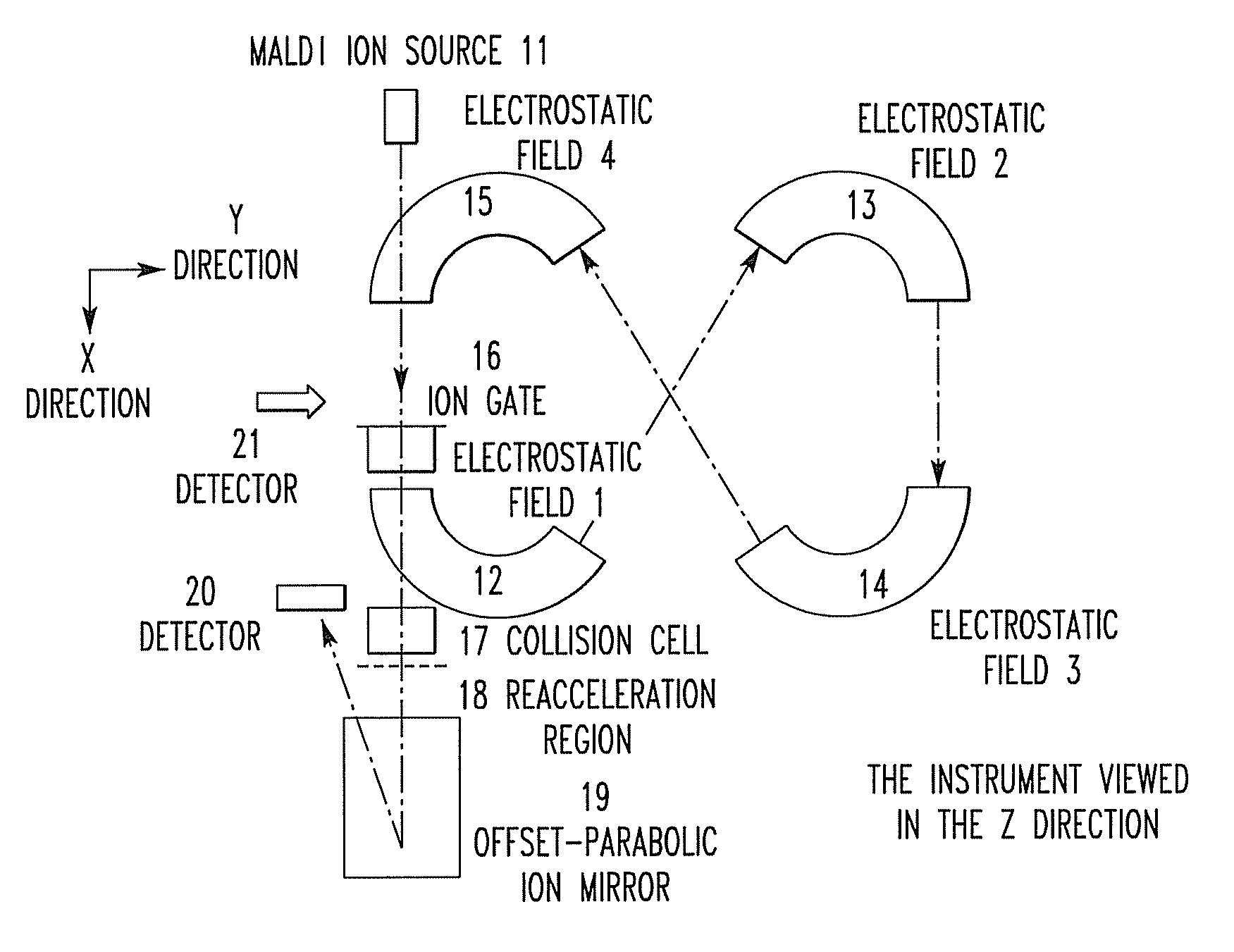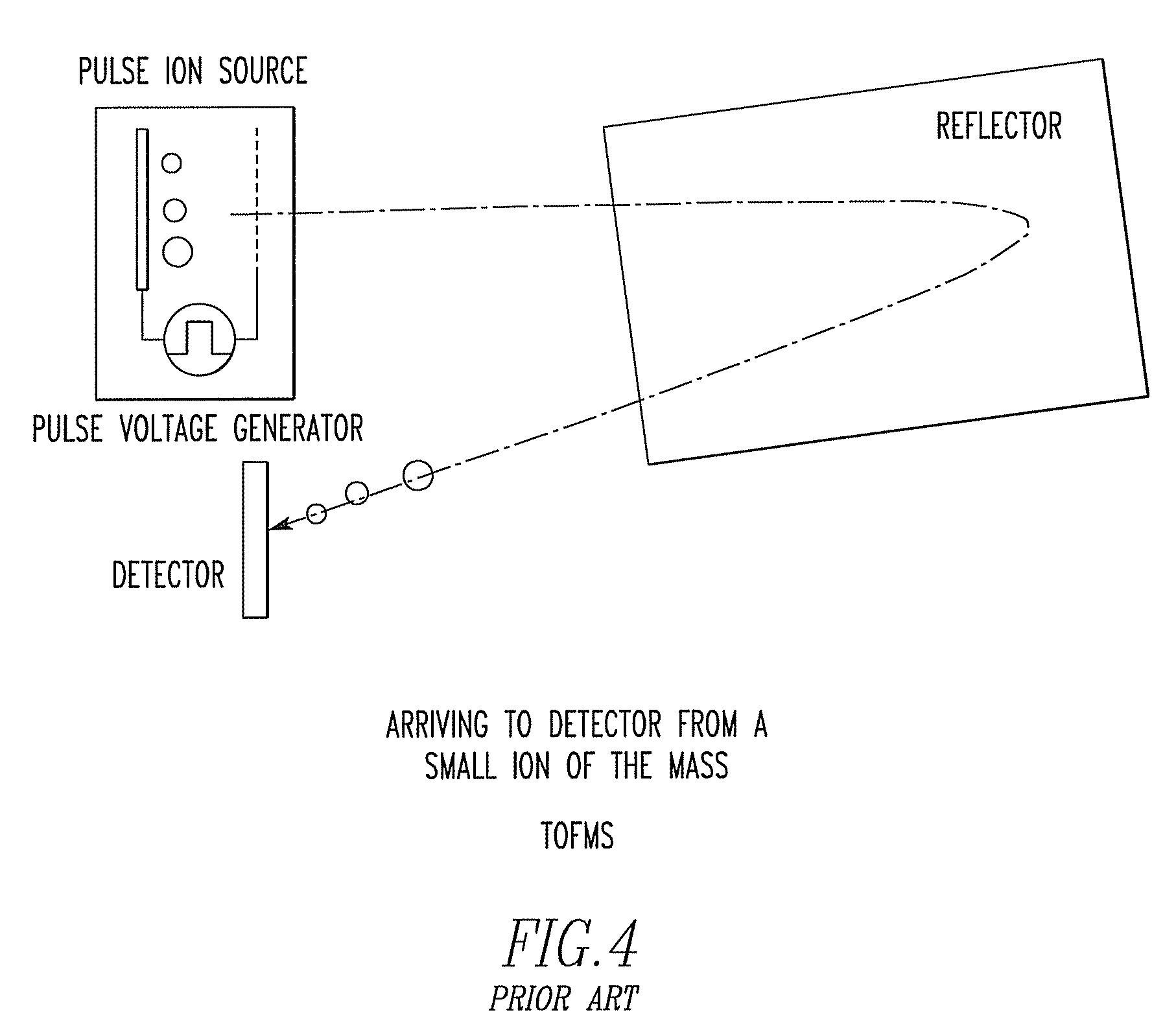Instrument and method for tandem time-of-flight mass spectrometry
a mass spectrometry and tandem technology, applied in mass spectrometers, separation processes, separation of dispersed particles, etc., can solve problems such as difficult analysis, complicated spectrum, and increased instrument siz
- Summary
- Abstract
- Description
- Claims
- Application Information
AI Technical Summary
Benefits of technology
Problems solved by technology
Method used
Image
Examples
first embodiment
[0099]FIGS. 9A and 9B show a tandem time-of-flight mass spectrometer according to a first embodiment of the present invention. In FIG. 9A, the instrument is viewed in the Z-direction. In FIG. 9B, the instrument is viewed in the direction indicated by arrows (Y-direction) in FIG. 9A. The spectrometer has a MALDI ion source 11, electric sectors 12-15 stacked on top of each other in the Z-direction to form an 8-shaped spiral trajectory, an ion gate 16 for selecting precursor ions, a collision cell 17 for fragmenting ions, an ion reacceleration region 18 formed between a spiral trajectory TOF-MS (hereinafter may be referred to as the first TOF-MS) and reflectron TOF-MS (hereinafter may be referred to as the second TOF-MS) and using a constant voltage or a pulsed voltage, a reflectron field 19 into which ions fragmented in the collision cell 17 are admitted, and a detector 20 for detecting ions reflected by the reflectron field 19. In this embodiment, the reflectron field is formed by an...
second embodiment
[0109]The present embodiment is similar to the first embodiment except that a detector 21 for MS measurements is added as shown in FIGS. 12A and 12B. Normally, the diameters of ion exit and entrance ports in the collision cell 17 are about 1 mm to secure airtightness. Therefore, there is the possibility that detecting ions passed through the collision cell 17 in MS measurements is disadvantageous in terms of sensitivity. Furthermore, as described previously, the mass dependence of the mass resolution during MS measurements can be reduced by shortening the distance from the sample plate to the focal point used in delayed extraction. For these reasons, better data can be effectively obtained in both MS measurement and MS / MS measurement by varying the focal point used in delayed extraction.
[0110]First, the compounds of a sample are ionized in the MALDI ion source. The resulting ions are accelerated by delayed extraction. The ion optics of the first TOF-MS are so designed that spatial f...
third embodiment
[0114]The present embodiment is a partial modification of the second embodiment as shown in FIGS. 13A and 13B. In the present embodiment, an ion passage hole 22 is formed in an electric sector that is located upstream of the circular path where the detector 21 is disposed and downstream of the circular path where the ion gate 16 is disposed. The collision cell 17, reacceleration region 18, offset parabolic ion mirror 19, and detector 20 are disposed on a straight line that is an extension of the flight trajectory extending straight from the ion passage hole.
[0115]In the case of MS measurements, a voltage is applied to the electric sector having the ion passage hole 22. The ions are made to travel in the spiral trajectory without permitting the ions to pass through the passage hole 22. In the case of MS / MS measurements, the electric field produced by the electric sector needs to be eliminated to permit the ions selected by the ion gate 16 to pass through the ion passage hole 22. Wher...
PUM
 Login to View More
Login to View More Abstract
Description
Claims
Application Information
 Login to View More
Login to View More - R&D
- Intellectual Property
- Life Sciences
- Materials
- Tech Scout
- Unparalleled Data Quality
- Higher Quality Content
- 60% Fewer Hallucinations
Browse by: Latest US Patents, China's latest patents, Technical Efficacy Thesaurus, Application Domain, Technology Topic, Popular Technical Reports.
© 2025 PatSnap. All rights reserved.Legal|Privacy policy|Modern Slavery Act Transparency Statement|Sitemap|About US| Contact US: help@patsnap.com



